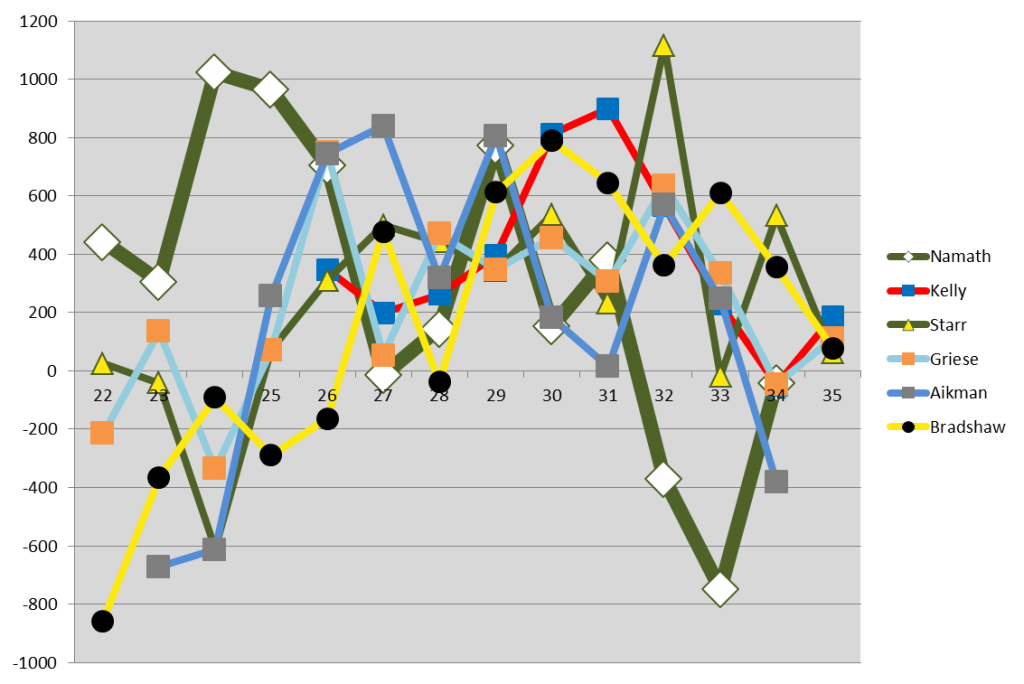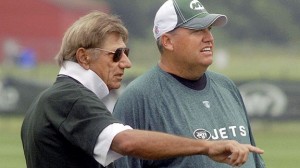A couple of years ago, my colleague Jason Lisk explained why Joe Namath is a legitimate Hall of Famer. With each passing year, it seems as though Namath’s career gets more misunderstood, particularly by those who look at his career stats without context. One of the main pieces of evidence that sounds damning: among Hall of Fame quarterbacks who began their careers after 1950, Namath ranks last in both touchdown/interception differential and passer rating:
But analyzing a player by his career numbers is too broad a brush for advanced analysis. Brandon Jacobs is 107 yards away from matching Gale Sayers’ career rushing total. Plaxico Burress and Jeremy Shockey have caught more passes than Lance Alworth and Kellen Winslow. At quarterback, comparing players across eras by their raw numbers is a pointless exercise. Byron Leftwich, Kyle Orton and Aaron Brooks have higher career passer ratings than Johnny Unitas. As always, we can only compare players by how they compared to their peers.
Namath’s career is misunderstood for several reasons. Younger fans think he’s famous because of The Guarantee, but he would have been an elite quarterback (and was acknowledged as one by his contemporaries) even if he never won a Super Bowl. He was among the best ever at avoiding sacks, an often overlooked but key element of effective quarterback play. He played in one of the worst eras for quarterbacks to compile strong passing stats, which is why his numbers don’t compare to modern quarterbacks. And his career arc was unusual, which further makes the use of career numbers an inappropriate way to understand Namath’s career.
There are 17 Hall of Fame quarterbacks to enter the league since 1950, and we can add Brett Favre, Peyton Manning and Tom Brady to get to an even twenty. Through age 26, Namath was outstanding, and was the second most productive quarterback of the twenty behind Dan Marino during those years. The table below [1]This list is sorted by how much Adjusted Net Yards over average each quarterback produced each season. This is calculated by taking each quarterback’s ANY/A, comparing it to league average, … Continue reading shows how much value was added by each of the twenty quarterbacks through the age of 26:
In fact, Namath, Dan Marino and Bob Griese remain the only quarterbacks to earn four Pro Bowls by the end of their age 26 seasons. And he remained the youngest quarterback to win the Super Bowl until Tom Brady in Super Bowl XXXVI. Namath was one of the most hyped quarterback prospects of his era, akin to how Andrew Luck is viewed today. Namath then signed with the AFL instead of the NFL, adding legitimacy to the younger league. He was given the largest contract in the history of professional football, and then lived up to that hype by having one of the best starts to a career of any quarterback in football history. But injuries would soon begin to chip away at Namath’s prime years.
Namath broke his wrist in 1970 and injured his knee in 1971, limiting him to just 8 starts during those two years. But in 1972, a healthy Namath had perhaps his finest season. Even with Don Maynard on his last legs, Namath led the league in passing yards, passing touchdowns, yards per attempt, net yards per attempt, adjusted yards per attempt and adjusted net yards per attempt. The Jets ranked 2nd in the league in both points and yards, behind only the undefeated Dolphins. Namath’s Jets also gave Miami one of their biggest scares of the season; the 24 points they scored were the most Miami would allow all year, but New York lost a fourth quarter lead and the game, 28-24.
In 1973, Namath missed most of the year with a shoulder injury, but he would win the Comeback Player of the Year Award in 1974. After ’74, Namath was effectively done, but played for three more seasons and put up miserable numbers.
Namath’s completion percentage was bad, even for his era, but consider the context. Namath took far fewer sacks than the average quarterback, and an incomplete pass is better than a sack. He was a vertical passer, and while that would hurt his completion percentage, he led the league in yards per completion three times. Namath played in a dramatically different era than today’s quarterbacks, which explains why his numbers may look poor compared to modern quarterbacks. And he hung around too long, lowering his career averages.
But from 1965 to 1974 he was the game’s among the top three quarterbacks in the game. Take a look at the stats [3]Note that individual sack data for the years 1965 to 1968 are estimated but unofficial, based on the data we currently have. of all quarterbacks over that ten-year period who attempted at least 1500 passes:
Even among his contemporaries, Namath’s completion percentage wasn’t very good. But he also was #1 in both sack rate and yards per completion, an incredibly difficult feat to pull off. Thanks to Namath’s incredibly fast release and his big arm, the Jets designed a vertical offense that was effective at moving the ball down the field. In the most basic form of passing measurement, Net Yards per Attempt, Namath ranked 1st by half a yard per attempt. In ANY/A, which includes a penalty for interceptions and a bonus for touchdowns, Namath falls just 0.01 ANY/A out of second place.
Namath’s career wasn’t one of the best ever, and it certainly wasn’t as good as it could have been. It’s well-documented that Namath was never able to fulfill his enormous potential because of a variety of injuries. But standing alone, even ignoring his post-season success, Namath’s numbers stand up as elite. He did throw too many interceptions, even for his era, although on more talented teams he would have likely been a more conservative passer. But for a decade, he was arguably the most dangerous passer in the professional football, putting aside all the glamour and glitz and guarantees.
I’ll close with a graph that doesn’t necessarily follow the rest of this post, but I made it for my own research and thought someone else might find it interesting. This graph looks at six Hall of Fame quarterbacks and shows how much value (as measured by ANY/A over average) each provided at various ages:

I’ve made Namath’s line twice the size of the others for easier viewing. It’s interesting to see how sharply Namath’s play fell off once he turned 32, one of the reasons his career numbers are so poor. But Aikman and Bradshaw also had multiple terrible years, just at the start of their careers. I’m not really sure what we can gather from this table other than I think it’s interesting to see the shape of a player’s career, and not just a summation in one number. Enjoy.
References
| ↑1 | This list is sorted by how much Adjusted Net Yards over average each quarterback produced each season. This is calculated by taking each quarterback’s ANY/A, comparing it to league average, and then multiplying the difference by the number of total attempts each quarterback had. |
|---|---|
| ↑2 | Bill Walsh once said that Namath was “the most beautiful, accurate, stylish passer with the quickest release I’ve ever seen.” |
| ↑3 | Note that individual sack data for the years 1965 to 1968 are estimated but unofficial, based on the data we currently have. |

